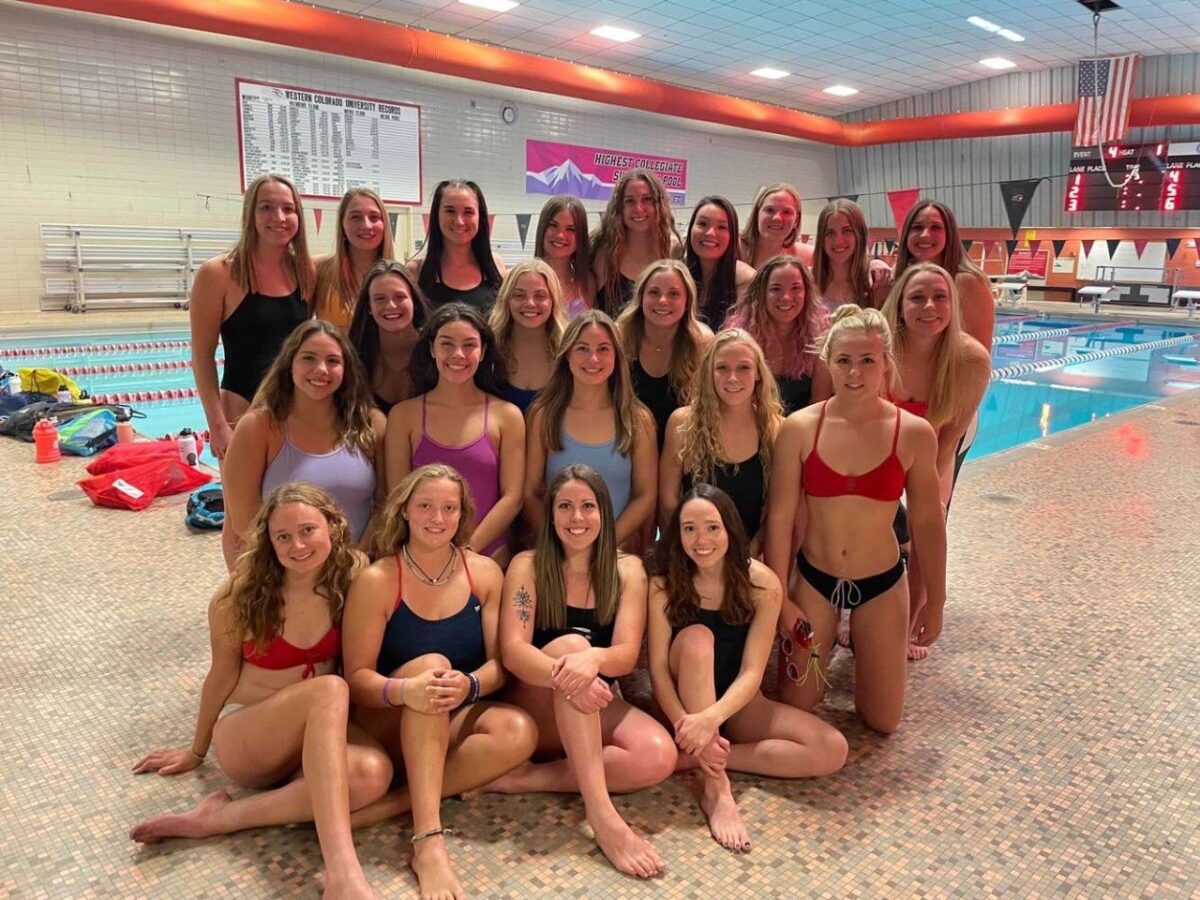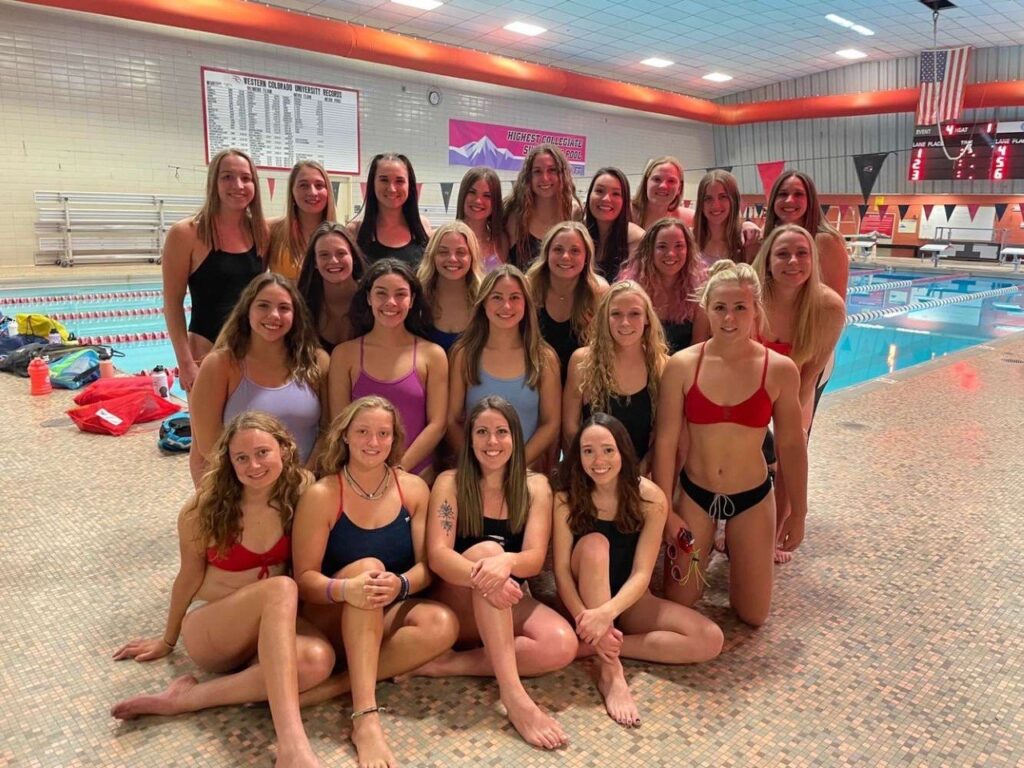
Mountaineers finds success at first meet
The Western Women’s Swimming and Diving team kicked off their 2021-22 season in style on Oct. 9 in a tri-meet, defeating fellow Colorado schools CSU-Pueblo (120-107) and Adams State (177-43) in Pueblo.
The Mountaineers were particularly strong in the relay portion, fielding teams which finished first and second in the 400-yard medley relay, with times of 4:14.24 and 4:15.61. The Mountaineers also dominated the 400-yard freestyle relay, finishing first and second. Three Mountaineers, Junior Addison O’Donnell and freshmen Courtney Coplan and Jordan Maruska competed in both winning relay efforts.
Western senior Sarah Mortenson led the diving team, winning the 3-meter event, and placing second in the 1-meter. The meet was a strong start for the Mountaineers, picked to finish fourth amongst the seven total women’s swim and dive teams in the Rocky Mountain Athletic Conference (RMAC) in the preseason coaches’ poll.
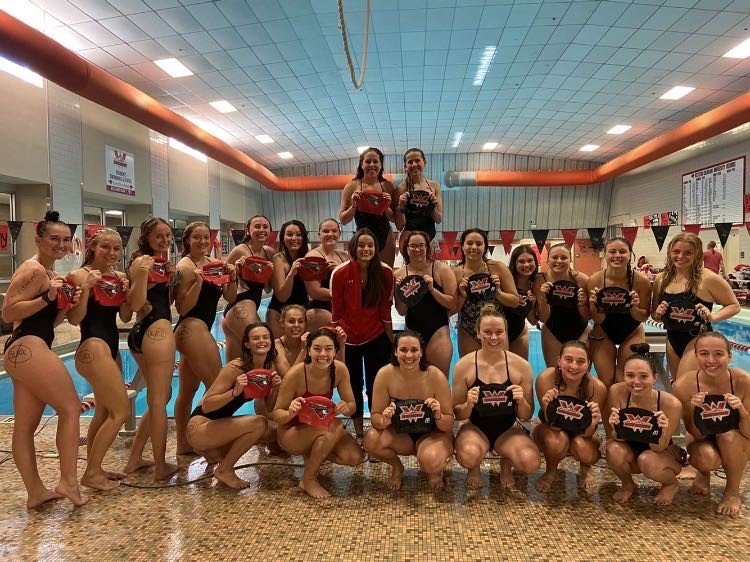
O’Donnell shines in her junior season
Addison O’Donnell, a junior who competes primarily in shorter “sprint” events in freestyle and breaststroke for the Mountaineers, is impressed by the speed of the incoming freshman this year. Strong first meet performances by Coplan and Maruska validate that observation. While this team may be young overall, with 14 of the team’s 23 swimmers being freshmen or sophomores, the team boasts loads of talent.
O’Donnell admits last year was challenging with the Covid pandemic. The team dealt with a mini virus outbreak, only competed in six total meets, and struggled mentally competing in a primarily individual sport with no fans with minimal opportunity for team bonding amidst a global pandemic.
However, O’Donnell has high hopes for this year, and the team is emphasizing cohesion and togetherness, starting with their car wash fundraiser held in September. New coach Vickie Fellows has eight regular season meets lined up between October and February, culminating with the RMAC Conference Championship on February 9th. The season will officially conclude, hopefully, with Western sending multiple qualifying swimmers and divers to the D-II National Championships in North Carolina in mid-March.
To make the National Championships, swimmers can get grouped into the “A” group by hitting certain times, ensuring their trip to nationals, or make the “B” cut with lower times, which puts them on a call-up list to fill out national events. Last year, O’Donnell was on the B cut list, but did not receive the highly anticipated call to nationals. This year, she is gunning to make the A cut.

Coach Fellows begins her tenure at Western
Coach Fellows has brought new rigor to the team during her short tenure, which began in Aug. 2021 after former coach Eric Matheson stepped down at the end of four seasons. Fellows emphasizes endurance swimming during practice, and breaks out the team into different focus sets to practice particular skills, which are rotated every practice. This is intended to produce better all-around swimmers, while still maintaining a keen focus on individual events.
Another point of emphasis this year has been improving swimmer’s efficiency of movement, particularly the watch they “catch” the water with their strokes. A high catch pulls more water and is thus more efficient, boosting performance. “I want to become more efficient as a swimmer, I notice that when I get tired my stroke falls apart” notes O’Donnell.
Besides their substantial time in the pool, the swimmers are up before dawn for weight training at 5 a.m. three times per week, focusing on exercises designed to stabilize their joints and avoid shoulder injuries, and on improving their leg and hip strength to increase explosiveness on their kicks, starts and turns.
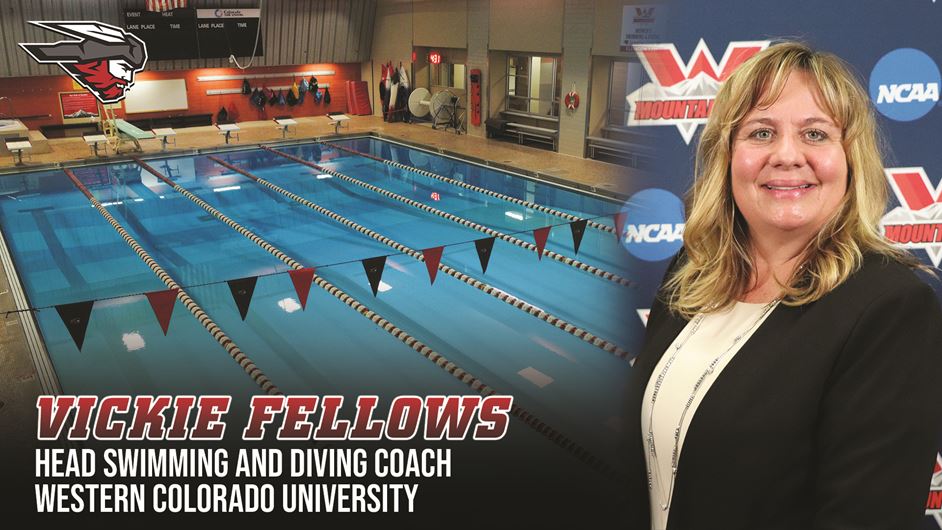
Source: Mountaineer Athletics
The mental game of swimming
O’Donnell thrives in the shorter events, but notes that she tends to over analyze races sometimes. During an event as short as the 50 freestyle, overthinking is a death knell. O’Donnell says that trusting your training and preparation is critical, and that staying out of your own head is a key to victory on meet days.
For longer events, like the 200 freestyle, O’Donnell explains that pacing is all-important. Her strategy is to “build” the first 100 fairly conservatively, swimming at 80 percent and then 90 percent the first two lengths. Next, she focuses on legs, “the first thing to go numb”, in the penultimate length, before finally letting it all loose in the final 50 with any energy she has remaining.
The Mountaineers Swimming and Diving team will compete in five more meets between now and winter break, and then they will take a week off for the holidays. After that brief break, they will return to Gunnison for several weeks of intensive training. This period is not all hard work and no play, however, as O’Donnell notes that they play sardines, essentially reverse hide and seek, in the nearly empty Chipeta Apartments during that time.
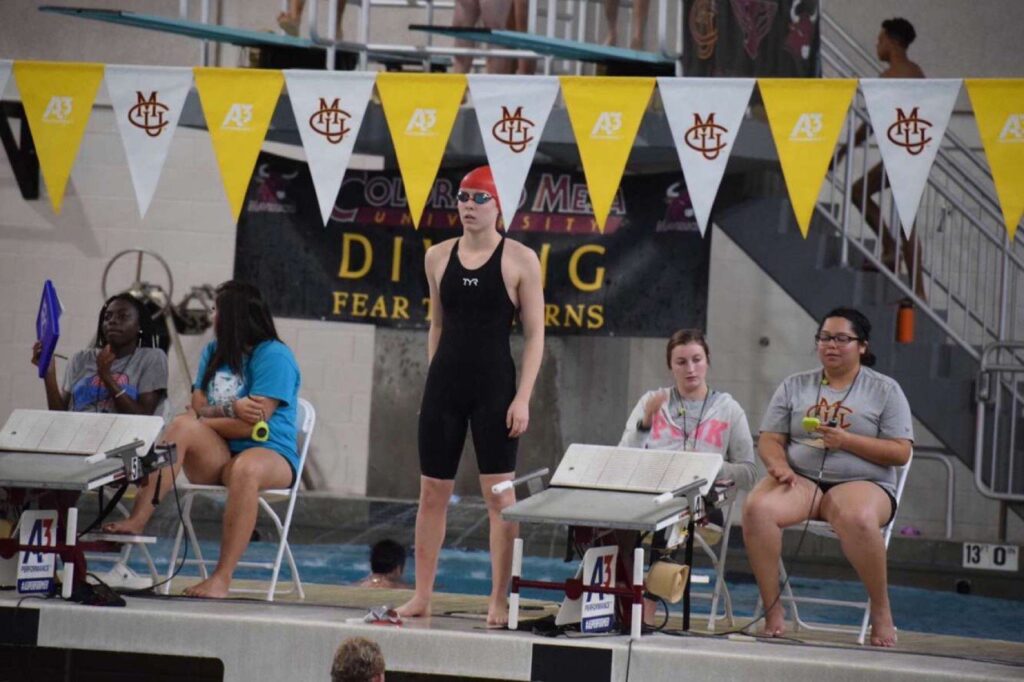
Packing the house
O’Donnell is in the early stages of planning the team’s Pack the House meet against Adams State. on Dec. 4, with the tentative theme of “bear hunting season”, a reference to Adams State’s mascot. She notes that relays are often the most exciting events, with team members and fans alike on their feet and yelling, creating an electric atmosphere.
“I don’t know what it is about swimmers, but they really like the song “Country Road”, and the song “Sweet Caroline”, O’Donnell notes, laughing at how these two songs seem to play at every meet.
The Mountaineers are hoping to make a roughly five day trip to Arizona over their holiday break to escape the cold, and to focus on training ahead of conference championships. For divers, the potential winter trip will hopefully mean practicing on platform diving boards and utilizing bubbles in the pool. The bubbles provide a clear visual for divers to focus on while in the air, and also cushion the impact when hitting the water.
For the swimming team, Colorado Mesa is the mark of excellence. “They’re crazy good, they’re crazy fast,” said O’Donnell, noting that Mesa invites D-1 schools to come to their pool to compete. The swim and dive team largely operate separately by nature of their different training regimes and schedules, but Sarah Mortenson, a senior diver who joined the revived dive team her freshman year for its first year back, notes that Mesa is a dominant force in diving too.
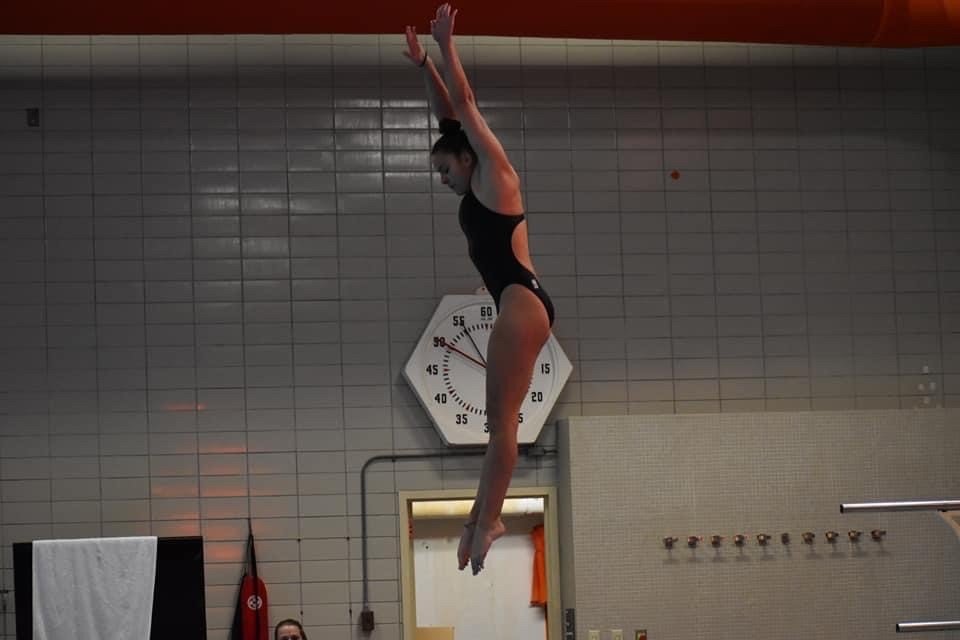
Mortenson leads Mountaineer divers
Mortenson is a converted gymnast, having competed in the sport since she was little. Back and knee problems drove her to diving in middle school due to its lower impact on the body. She notes that landing on your head was a foreign concept compared to gymnastics, where landing on your feet is always the goal, but otherwise the transition was not too difficult, with both sports utilizing similar skills.
In Division-II diving, divers compete at 1 and 3 meter heights. Mortenson says the name of the game for her this year is perfecting her execution for 1-meter dives, and digging into a goal list of expanded dive options at 3-meter to score higher. Western’s pool does not have a 3-meter diving board, but the team travels to Montrose once a week to practice the 3-meter dives.
There are five different categories of dives: fronts, backs, reverses, inwards, and twisters. Mortenson likes to “chuck” dives, going for the fastest spin possible, citing her inward dive, the front two-and-a-half, and her back one-and-a-half as her personal favorites, and also her most consistent variety of dives.
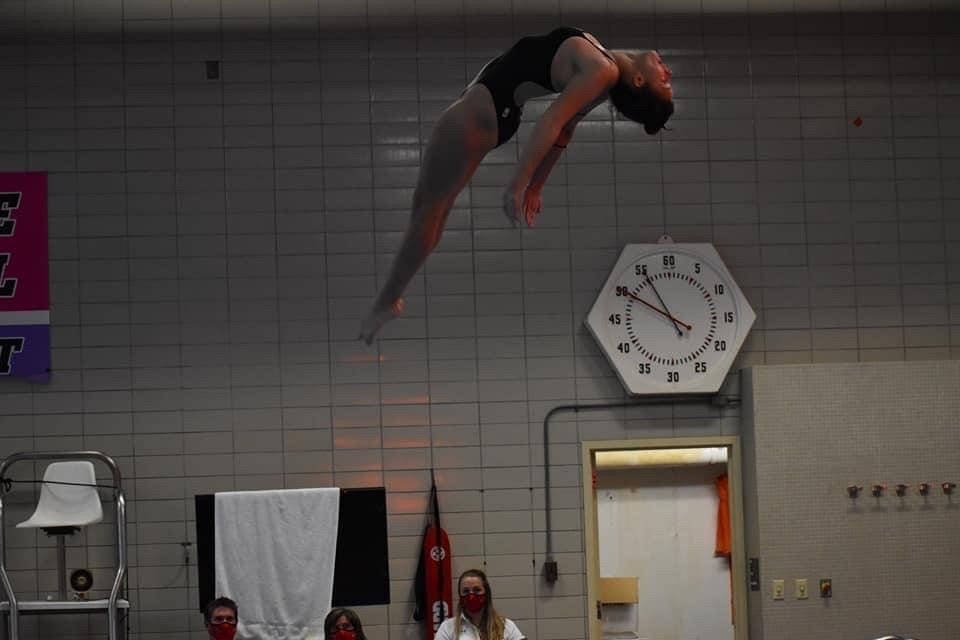
The art of diving
Divers get “calls” from their coaches during practices, where coaches tell divers when to open up to complete their dive. These calls are not allowed during meets, but help divers orient themselves in the air and get their timing down pat for competitions. For more experienced divers, these calls may not be necessary for the 1-meter, but become more important in the 3-meter, especially during feet-first dives, where it is more difficult to calibrate body positioning.
Mortenson’s ultimate goal is to qualify and go to nationals in March, particularly in the 3-meter event. She also aims to “throw” front three-and-a-half and back two-and-a-half dives over the course of the season, expanding her dive repertoire and going for bigger points.
Diving is a different animal than swimming or other sports, and several nearby schools, including Adams St. and Colorado School of Mines, currently do not field any divers, sacrificing the respective points during meets. Mortenson cites CSU Pueblo and Colorado Mesa as the dive team’s biggest competition, but notes that diving is a unique beast.
“Diving is different from swimming because it doesn’t feel like there is as much rivalry. You really cheer each other on, even if they are from the opposite team. You are definitely competing against yourself a lot, because you know what everybody can do, and in your mind you are just trying to do your best” notes Mortenson on diving culture.
Looking to the future, the new Western dive coach, Liam Acosta, envisions a future where the team standards are raised with better equipment, ideally a 3-meter board on Western’s campus, and elevated levels of fitness and training.
Looking ahead
Heading into the bulk of their season, Western Women’s Swimming and Diving is looking to build on their early success and maximize their young talent. Next up, the team will face a serious test when they travel to Grand Junction to face off with Colorado Mesa, the Colorado School of Mines, and Augustana University from South Dakota on Oct. 22 and 23.

